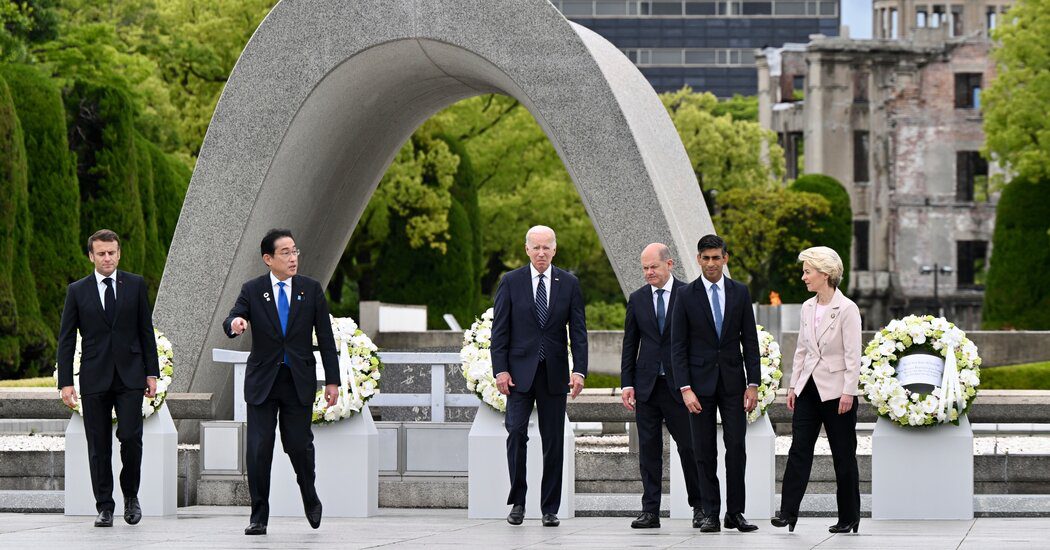Global Courant 2023-05-20 08:07:14
President Biden told U.S. allies on Friday he would allow Ukrainian pilots to be trained in American-made F-16 fighter jets, to ensure other countries give the planes to Ukraine — a major upgrade to the Ukrainian military and a sharp reversal.
Since Russia launched its full-scale invasion of Ukraine 15 months ago, officials in Kiev have been calling for advanced fighter jets to overcome Russian air superiority. But Mr. Biden had resisted, fearing the jets could be used to hit targets deep inside Russia and push the Kremlin to escalate the conflict. Pentagon officials have said other weapons, especially air defenses, were more urgently needed and that the high cost of the F-16s could displace other equipment.
But several European countries that belong to the NATO alliance and have F-16s in their arsenal have called for an international effort to provide training and transfer of their jets to Ukraine. This requires American permission, because the weapons were first sold to them by the United States. While not the most advanced U.S. fighter, the F-16 has a powerful radar that can spot targets hundreds of miles away and modern missiles and other technology that U.S. officials don’t want to see duplicated or fall into hostile hands.
Mr Biden told other leaders of the Group of 7 countries, the world’s richest democracies, at their summit meeting in Hiroshima, Japan, about his pilot training decision, paving the way to supply Ukraine with fighter jets.
Jake Sullivan, the national security adviser, said Saturday morning in Hiroshima that the United States and its allies will discuss in the coming months how to provide Kiev with the jets themselves. The United States is not expected, at least under current plans, to send its own F-16s.
“I welcome the historic decision by the United States and @POTUS to support an international fighter jet coalition. This will greatly strengthen our airborne army,” President Volodymyr Zelensky of Ukraine, who is expected to address the Group of 7 this weekend, wrote on Twitter.
In a joint statement, Allied leaders said they were determined “to continue our security assistance to Ukraine as it defends itself against Russia’s aggression, and to tailor our support to Ukraine’s needs.” The group pledged to provide “for as long as necessary financial, humanitarian, military and diplomatic support that Ukraine needs”.
Earlier on Friday, Mr. Zelensky addressed an Arab League summit in Jeddah, Saudi Arabia, where he questioned the neutral stance many Arab countries have taken on the war and begged them to help save Ukrainians “from the cages of Russian prisons”.
“Unfortunately, there are some in the world, and here among you, who turn a blind eye to those cages and illegal annexations,” he said. “I’m here so that everyone can have an honest look, no matter how hard the Russians try to influence.”
According to the Japanese foreign ministry, Mr. Zelensky will appear at the Hiroshima summit on Saturday to address the leaders of the Group of 7.
Ukraine is expected to launch a major counter-offensive soon, hoping to recapture more territory that Russia seized in the early days of the war. Any delivery of fighter jets would be months away, too late to affect that plan.
The leaders of the Group of 7 in Hiroshima spent much of the day discussing the upcoming counter-offensive and the chances of forcing Russia to the negotiating table to discuss some form of truce that would stop the fighting , even if that would not solve the central issues of the war. war.
They are also about to unveil a slew of new sanctions and export controls to further curtail the Kremlin’s financing of the war, and crack down on third parties who have secretly supplied Russia with banned technologies that can be used in weapon systems.
The allies seem determined to show a united determination to support Ukraine at a time when Russia’s President Vladimir V. Putin appears to be betting that their interest and commitment will wane.
Mr Biden’s changed stance on F-16s is his latest U-turn on allowing Ukraine to use advanced weapons, including HIMARS missile launchers, Patriot air defense missile systems and Abrams tanks. In both cases, the president initially refused, but under pressure from European allies, he changed his mind.
Top Pentagon officials have consistently said they do not believe Ukraine needs F-16s at this stage of the conflict.
Celeste A. Wallander, the assistant secretary of defense for international security affairs, told the House Armed Services Committee last month that advanced Western warplanes were only “about eighth” on Ukraine’s priority list. She said officials have focused on “top priority assets, and those are air defense, artillery and armor.”
But the push for F-16s by Ukraine and its supporters in Congress intensified this week when Yahoo News reported that an internal US Air Force assessment found that it would take only four months to train Ukrainian pilots to operate the fighters, a much shorter time frame than Pentagon officials had previously cited.
The document, which a senior Air Force official confirmed and said had been shared with several NATO allies flying F-16s, contained a detailed assessment conducted at Morris Air National Guard Base in Tucson in late February and early March. , Ariz. Two Ukrainian pilots were judged to have received “no formal training” on the F-16, other than a brief familiarization period, and then were tested on a flight simulator for several hours.
An appearance by Mr Zelensky in the Group of 7 would be a strong rejection of Mr Putin and a reminder of how profoundly relations with Russia have deteriorated. Thirty years ago, President Clinton met with Boris Yeltsin, then the President of Russia, in Japan to chart the integration of a post-Soviet Russia into the world economy as Clinton pledged to pursue the repeal of Cold War sanctions . Five years later, Russia joined what became the Group of 8.
Now that has all been reversed. After Russia annexed Crimea in 2014, it was suspended from the group and completely abandoned three years later. The Russian economy is grappling with sanctions imposed since last year’s invasion, especially the price cap on oil sales, with more to come.
Britain said it did on Friday implement a ban on Russian diamonds, copper, aluminum and nickel. Australia too said on Friday, it imposed new financial sanctions against 21 entities and three individuals, including Russia’s largest gold company, petroleum and steel companies and defense entities.
The United States also rolled a “substantial packageof restrictions, including cutting an additional 70 companies from U.S. exports and adding more than 200 individuals and entities to the sanctions list. The measures are intended to crack down on people or companies that help Moscow to circumvent existing sanctions.
The new round of sanctions “will further tighten Putin’s power to wage his barbaric invasion and further our global efforts to cut off Russian attempts to evade sanctions,” Treasury Secretary Janet L. Yellen said in a statement Friday. .
The United States will broaden sanctions to cover more corners of Russia’s economy, paving its way to acquire semiconductors and other high-tech goods from Group of 7 countries, which U.S. officials said on Friday are critical to its ability of Russia to build weapons. Antony J. Blinken, the secretary of state, said in a release that the new sanctions would target parts Russia needs to build a drone currently deployed in Ukraine.
The new sanctions also aim to strain Russia’s ability to drill for oil and gas, as well as narrow-minded venture capitalists and financial services firms that US officials said helped sanctioned Russian companies.
Goods that Western companies are now not allowed to sell to Russian buyers often reach them through intermediaries – they change owners, legal jurisdictions and free trade zones several times. The trade is difficult to track and more difficult to enforce, especially for dual-use goods that have both civil and military uses.
With many of Russia’s other revenue streams squeezed by past sanctions, officials have turned to diamonds as a lucrative trade that continues to provide Moscow with funding for its war. Russia is the world’s largest supplier of small diamonds, with exports exceeding $4.5 billion in 2021, making the gem the top non-energy export by value.
Victoria Kim contributed reporting from Seoul.








